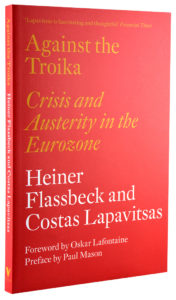

This is part of our round table on Against the Troika: Crisis and Austerity in the Eurozone.
In Against the Troika, Heiner Flassbeck and Costas Lapavitsas offer a blistering critique of the functioning of economic and monetary union (EMU), from the original bargain struck with the Maastricht Treaty, through the imposition of austerity policies during the sovereign debt crisis. The book is an interesting mix of economic theory combined with a political call to arms that tries to address numerous audiences. Written in an accessible style, this hybrid treatment risks not engaging extensively enough with economic theory (there are not a lot of references for the various economic arguments they mention, for example) to convince those who are not already sympathetic to their cause. While the title suggests that the analysis will delve into the politics of the troika, the book does not go into much detail in this regard. Instead, it focuses on criticizing the economic rationale for EMU that benefits German capital at the expense of other interests, including German labor. This leaves countries in the periphery, particularly Greece, permanently disadvantaged, and this situation will only change with radical policy measures.
The book posits that EMU has been dominated by neoliberal interests in the European Central Bank (ECB) and the European Commission, and offers a Keynesian critique and solution.
The book posits that EMU has been dominated by neoliberal interests in the European Central Bank (ECB) and the European Commission, and offers a Keynesian critique and solution. It begins with a theoretical explanation for EMU, arguing that a single currency requires “above all, coordination of price and wage evolution” (6) in order to “compensate for the loss of exchange rate flexibility” (14). Indeed, they maintain that economic theory is inconsistent regarding monetarist ideas on inflation and neoclassical ideas of labor markets; instead, unit labor costs should be managed according to agreed-upon inflation targets so that prices and wages evolve together. According to the authors, EMU has been focusing on the wrong indicators. The ECB should focus on unit labor costs, not money supply, when determining inflation. In addition, more attention should be paid to restoring flows rather than dealing with stocks, whether it is government debt or bank balance sheets. Moreover, the Commission’s treatment of current account surpluses (which are reviewed when reaching 6 percent of GDP) versus deficits (which are reviewed at 4 percent of GDP) reflects the “neoliberal approach the old Commission has never dismissed” (51).
During the first decade of EMU, unit labor costs diverged across the euro area. Robbed of the ability to devalue (because the euro is a shared currency) or retaliate through trade policies (because of the single market and common commercial policy), countries in the periphery were powerless to respond as their competitiveness suffered. Moreover, economic suffering was not limited to the periphery: German workers also have borne the brunt of this policy that caused domestic demand to plummet. The authors portray Germany’s economic success as illusory: “EMU has been tremendously beneficial to German exporting capital, but not to German workers and households” (48) as “moderation in wage growth in Germany has significantly weakened domestic demand…and even dampened investment” (4). The authors go so far as to deem “Germany as the source of the Eurozone crisis” (21) for violating the ECB’s inflation target of 2 percent by placing downward pressure on its wages.
Some of the economic arguments are familiar, though the book itself does not take pains to reference earlier iterations of some arguments.
Some of the economic arguments are familiar, though the book itself does not take pains to reference earlier iterations of some arguments. For example, chapter four portrays the sovereign debt crisis as a foreign exchange crisis in which EMU countries had to undergo a painful internal devaluation, which already had been covered by authors like Paul De Grauwe. Similarly, they contrast Keynesian versus neoliberal ideas of current account balances, asking if savings lead to investment but giving few citations. They also advocate the use of devaluation (70), “the most frequently used mechanism in modern history to respond to the behavior of an aggressive trading partner without engaging in outright protectionism.” Nevertheless, they do not engage in the economic debates from the 1980s and 1990s on how devaluation (especially in Europe) contributed to a cycle of inflation and macroeconomic stability.
In addition to Germany (and the troika), the authors take aim at the European Left for their “unwillingness…to confront directly the vexed issue of the common currency but also the nature of the EU as that has evolved in recent decades” (73). They posit the existence of an “impossible triad” (76): effective debt restructuring; abandoning austerity; and continuing to operate within the EU institutional and policy framework, particularly EMU. If a Left government were to become confrontational, the main bargaining chips that the EU has are the provision of liquidity to banks by the ECB and the prospect of official lending to governments (77). Given the rapid evolution of the Greek crisis during the summer of 2015, in which the imminent withdrawal of emergency liquidity assistance necessitated the imposition of capital controls and threatened the collapse of Greece’s banking system, their analysis appears quite prescient.
As long as Greece remains in EMU, the authors contend that it is doomed because it belongs to a monetary union of unequals, which privileges the interests of creditors. Debt restructuring, devaluation, the end of austerity, and a return to collective bargaining figure among their numerous policy proposals. Moreover, they suggest the creation of a parallel currency that could be used should a country (or even better according to the authors, a group of countries) exit the euro area.
Given the strident and revolutionary nature of the final chapters, it would be tempting to dismiss the book as a leftist wish list. However, even those with more pragmatic leanings would benefit from considering seriously the implications of their “impossible triad.” Perhaps the book tries to do too many things at once, but this should not detract from its contribution to a debate that is dominated by neoliberal ideas.
Michele Chang is a professor in the Department of European Political and Administrative Studies at the College of Europe (Bruges) since 2006. She is currently on the Executive Board of the European Union Studies Association (since 2013) and the Board of the Trans European Policy Studies Association.
Against the Troika: Crisis and Austerity in the Eurozone
by Heiner Flassbeck and Costas Lapavitsas
Verso Books
Paperback / 144 pages / 2015
ISBN: 9781784783136
Published on January 5, 2017.




